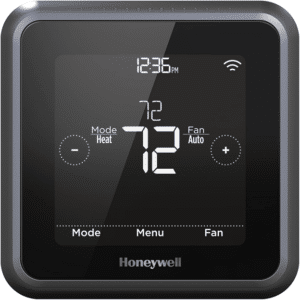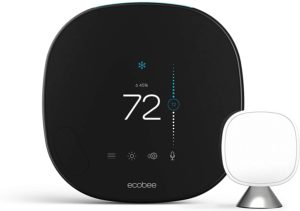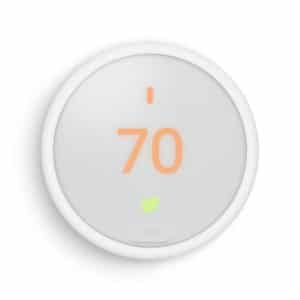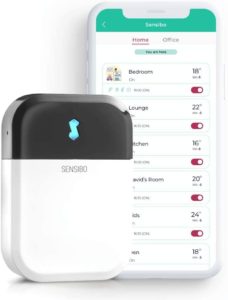Put simply, a smart thermostat can do the thinking, so you don’t have to. Depending on the model, it can learn your schedule and figure out when no one is home; it can turn down your heat when you leave and get things toasty warm for when you return. The efficiency of automating your thermostat can help save money on energy bills at a time when costs are skyrocketing.
Table of Contents
Do smart thermostats reduce energy use?
Smart thermostat manufacturers love to boast about the energy savings and financial benefits of their products, but do smart thermostats really reduce energy use?
In short, yes. The longer answer, though, is that this largely depends on individual circumstances.
Upgrading to a smart thermostat if you have electric space heating could reduce energy use for heating that space by an average of 9%, according to BC Hydro, the energy provider where I live. In some places, a smart thermostat could save even more energy, up to 20% according to Nest’s research. However, this was a comparison of people who switched to Nest compared to just leaving the thermostat at a steady temperature all winter.
See also: The best air quality monitors for home use
All in all, your potential energy savings depend on:
- Your current habits and preferences
- The climate where you live
- The energy efficiency of your home.
If you’re reading this, chances are you may already be optimizing your energy use, meaning that savings may be minimal with a smart thermostat. And if you like to keep your home super toasty or are a miser with the heat and much prefer a cozy sweater or three, getting a smart thermostat likely won’t change those habits. Also, if you have a particularly erratic lifestyle, with lots of coming and going from home, or if you work from home or have opposing schedules, a smart thermostat may not be especially beneficial.
However, if you have a somewhat erratic lifestyle and are always forgetting to turn off the heating when you leave the house, a smart thermostat may be an enthusiastic energy-saver! Especially if you get one with an app through which you can remotely control the heating system, for those times when you say to yourself ‘wait, did I turn off the heat?’
Other times when a smart thermostat may prove energy-saving include if you don’t currently use ‘setbacks’ and want to start using them; if you’re willing to knock the ambient temperature down by a degree or so and bundle up; if everyone has a very regimented schedule; and if you’re often away for long periods of time (from a weekend to several weeks) and leave the temperature steady all that time.
Programmable thermostats are only as good as their users, but smart thermostats can benefit even those who don’t have the inclination or technical expertise to program a regular thermostat. With a smart thermostat, you can usually take a more hands-off approach, with auto-away, motion detection, and scheduling much easier than with a clunky programmable system.
Myth busting! It’s a common misconception that it takes more energy to warm a home to a comfortable temperature after being cool for many hours. In fact, it only takes about as much energy to reheat a home as was saved when the temperature first dropped. So, the longer the home stays cool, the more energy you save. No need to keep it at a comfortable temperature all day unless you’re actually at home!
Climate and energy efficiency
As for climate, if you live somewhere where winters are mild and summers aren’t sweltering, a smart thermostat may have little impact on energy consumption. However, if you live somewhere with a more extreme climate, such as Chicago, say, where winters are really cold and summer is intensely hot and humid, a smart thermostat could easily save energy by better managing the temperature and humidity for you.
The construction of your home, and where it’s situated, also matters when it comes to energy savings with a smart thermostat. A home that is super energy efficient, requiring little in the way of cooling and heating throughout the year, is unlikely to translate to big savings by installing a smart thermostat.
In contrast, if you have a ‘leaky’ home, with little insulation, older single pane or failed double pane windows, older doors, and an unfinished basement, a smart thermostat could mean big savings for you. The same goes if you don’t share walls, floors, or ceilings with neighbors who heat or cool their homes.
How much money can a smart thermostat save you?
It’s not guaranteed that a smart thermostat will save you any money, let alone pay for itself within the year of purchase. That said, over time, a smart thermostat can chip away at your energy use and save you a few dollars here and there. The most likely savings are going to be in homes where you have separate thermostats controlling different zones/rooms/floors. After all, there’s little point keeping a guest room super toasty if nobody uses is for 10 months of the year.
Somewhat obviously, the more you currently pay per unit of energy, the higher your potential savings. If electricity or gas is cheap where you live, however, your savings will be correspondingly smaller.
Let’s consider a scenario where you install a smart thermostat and set it to keep the temperature low for the 9 hours or so that everyone in the house is away at work or school. If you lower the temperature by just 6 degrees for 8 hours during the day and by 4 degrees for around 6 hours overnight, this could save you around 18% on your bill (because you typically save 0.25% per degree per hour).
Let’s say your bill is $100 a month. This kind of saving would mean you’d only pay $82 a month, adding up to around $216 a year in savings. That’s enough to buy you a decent smart thermostat. With rebates, you could start saving money even earlier (so be sure to check with your energy provider before buying!).
Top tip: Not sure what temperature to set your thermostat at? A setback from 21° C (70° F) to 16° C (61° F) overnight can result in energy savings of 10%. Similarly, lowering the temperature from 21° C (70° F) to 20° C (68° F) when you’re working around the house, rather than just sitting watching TV or reading, can also save energy. And when no one is home, set the thermostat to 16° C (61° F) to keep the house safe but not overly heated.
The best smart home thermostats for energy savings
If your current heating setup isn’t doing the trick, check out our list of top picks for eco-friendly space heaters, or if the inverse is true, we’ve also written about the best energy-efficient air conditioners too.

Honeywell Home T5+ Smart Thermostat
Highlights: Affordable, attractive, with all the functionality and versatility most homeowners need to save energy, time, and money
The Honeywell Home RCHT8612WF T5 Plus Wi-Fi Touchscreen Smart Thermostat offers 7-day flexible programming and geofencing technology in a sleek black design that is easy to use and easy on the eye. It is Energy Star certified, is easy to install and can be used either with an existing C-wire for power or the optional power adapter for low-voltage that won’t fry any circuitry.
Offering both 7-day flexible programming and geofencing (but not both at the same time), the Honeywell is versatile enough for most homes’ needs. If you have a larger household and a more predictable schedule, use the programming function. If you live alone and have a less predictable schedule, use the geofencing option.
The T5+ also offers smart alerts, i.e. push notifications to let you know it’s time to change your furnace filter or if there’s a weather alert. This model also has custom fan settings that can support better indoor air circulation, wiring dependent. And it automatically determines whether heating or cooling is needed to keep your home comfortable.
You can operate the smart thermostat from your smartphone or tablet, can integrate the T5+ with smart lighting and other smart technology, and it may help you qualify for energy rebates with your utility company.
One other thing I like about the Honeywell Home T5+ Smart Thermostat is that it retains your settings during power outages, at least for brief interruptions (it will revert to factory settings after lengthy power outages). And, because the thermostat is operated via an outside server, you’ll be notified (assuming you’re getting push notifications) of any power outages. This is particularly helpful if you’re relying on the thermostat at a second home where pipes might freeze, for example.
Installation is straightforward and takes about 30 minutes to an hour, depending on your set-up. Most folks seem to have no trouble replacing their old thermostat with the T5+ and getting it connected to their WiFi router. That said, one issue does seem to pop up time and again, but this isn’t Honeywell’s fault. If your network router has the Plug ‘n’ Play (or UPnP) protocol enabled, your thermostat is very likely to connect to the WiFi but not be able to register. So, before you try to set up the thermostat, check your router setting and disable UPnP (which isn’t very secure anyway!).
Finally, the Honeywell T5+ is compatible with Apple HomeKit, Amazon Alexa, and Google Assistant, so once you’re all set up, using it via voice command will be a breeze.

Ecobee Smart Thermostat with Voice Control
Highlights: Comprehensive and versatile smart thermostat with built-in Alexa for ultimate control of your home environment
The Ecobee smart thermostat with Voice Control works with most smart-home platforms, but if you get the bundle with the switch, you get built-in Alexa that offers the most comprehensive control of your home environment yet. This system can play music, update you on the news and weather, control your smart lights, make voice calls, and, oh yeah, adjust your heating and cooling system.
The Ecobee has been redesigned and reengineered and now sports a crisp glass finish and easy to read touch display. It is one of the few smart thermostats to work on 2.4GHz and 5.0GHz and is responsive to voice command even from pretty far away.
The smart sensor technology helps keep rooms comfortable by adjusting your heating and cooling system according to occupancy and temperature. You can also control your thermostat through voice command, through your smartphone, tablet, Apple Watch, computer, and in many other ways.
It also comes with a remote sensor, so is great for homes where you have a strangely cold or hot room. You can add up to a staggering 32 sensors, making this a great option for a sprawling home with multiple wings, nooks, and crannies. And the presence sensors make sure to not heat rooms you’re not occupying, which helps save energy and money.
Speaking of saving money, the Ecobee Eco+ functionality intelligently heats or cools your home when energy costs are lowest during the day, thereby providing even greater savings costs without compromising comfort.
This system takes about 45 minutes to an hour to install (less if you choose the basic package without the Switch+) and they offer video walkthroughs and a step-by-step guide via their app. It integrates with Google Assistant, Apple Home Kit, Alexa, Samsung SmartThings (great for if you have an eco-friendly Samsung refrigerator!), and IFTTT.
The Ecobee works with home heating and cooling systems that lack a C-wire, thanks to the Power Extender Kit included in the box. So, while it doesn’t ‘learn’ in the same way the Nest does, the Ecobee will work with far more systems and is far more intuitive and easier to integrate with your existing technology. It also works offline, making it a good choice for places where power outages are more common as well as for vacation homes where freezing pipes might be an issue.

Google Nest Thermostat E
Highlights: When it works well and is properly installed, the Nest Thermostat E is an inexpensive smart thermostat that looks great and requires little human input.
The Google Nest Thermostat E is a strong runner-up for a smart thermostat. As the junior version of the Nest, the E model balances budget and functionality, has a modern aesthetic, and has many satisfied customers. Indeed, the E’s slightly less expansive functionality may actually be a bonus if you’re looking for a smart thermostat that works well with little input required from you.
This smart thermostat learns your routines and preferences and creates an optimized heating and cooling schedule with no need for you to program it yourself. However, if your household is extremely erratic, you’ll want to program it yourself as thermostats that learn such a ‘routine’ could fry your furnace by turning your heating and cooling on and off constantly.
Also be aware that any Nest smart thermostat could fry your heating system in another way. These thermostats all work on 24V and require a C-wire for power. Hooking one up to a 110V or 240V wire won’t go well, so just don’t do it. Also, if you don’t have a C-wire, the Nest may try to draw power from your heating system’s circuit board by quickly turning it on and off (pulsing).
So, if you’re thinking of MacGyvering your system to try to save the $150 or so to have an electrician install a C-wire, consider that you may well end up with a broken thermostat and a whopping bill to replace your HVAC’s circuit board. The Nest also operates on a rechargeable battery pack, but these don’t seem very reliable as a way to run the thermostat without additional power. And what’s the point of a smart thermostat where you have to remember to charge the batteries constantly?
The Nest Thermostat E isn’t compatible with quite as many HVAC systems as the more expensive Nest models, but still works with around 85% of systems. It also works with Nest Temperature Sensors, so is great for homes with problematic hot or cold spots. And it’s compatible with Amazon Alexa and Google Assistant, but is not compatible with Siri/HomeKit.
The aesthetic of the Nest Thermostat E is quite different to that of the Honeywell T5+ as it is round, made of plastic, and has a frosted white display. Some people find the display hard to read, but this might well depend on the angles of light where you install it. The Nest Thermostat E makes it easy to check how much energy you use every day. View energy usage via the app and this could help you figure out more ways to save.
Honeywell still pips the Nest to the post though as it’s less expensive, easier to install in more homes, and is made by a company with an impressive commitment to sustainability and social enterprise.

Sensibo Sky
Highlights: Smart thermostat to make your window and wall A/C work for you (and save money!)
Do you live in a home or apartment without HVAC? Need a smart way to control your window or wall A/C? Check out the Sensibo Sky (View Price on Sensibo). This smart thermostat is compatible with Alexa, Google Home, IFTTT, and other platforms, syncs up quickly and easily with many window A/C and wall A/C units as long as they have an infrared remote, and lets you control your home temperature remotely in addition to scheduling and geofencing.
The Sensibo offers 7-day scheduling, has a humidity and temperature sensor, and works with split air conditioners and window air conditioners to help save energy and save you money.
Other advantages of a smart thermostat
A smart thermostat might also be a great purchase for vacation properties. Why? Because it can allow you to remotely maintain a certain temperature to stop pipes freezing, then warm things up for when you arrive. That way, you aren’t heating all-year round and wasting energy and money.
Energy savings and a reduced energy bill aren’t the only advantages of a smart thermostat. These devices can also offer peace of mind, especially if you have a vacation rental or are away from home for longer than expected. Smart thermostats that you can control through an app offer the convenience of being able to warm up the house just prior to your arrival, or turn off the heating if you’re unexpectedly away outside of your usual scheduled programming.
Smart thermostats can also make your home more comfortable in general, by minimizing the need to blast the heat when you get home, and avoiding the icy walk to turn up the dial first thing in the morning.
One final advantage of a smart thermostat is that it can start to teach you better habits. For instance, if you have a device that monitors your presence in your home, it can help highlight when your programmed schedule doesn’t line up with your actual comings and goings. Handy reminders and insights can offer prompts to turn down the heat an hour earlier, say, or delay increasing the temperature until closer to when you actually get home.